Choosing a mic for recording vocals can be one of the most important decisions you’ll make while setting up your studio. Whether you’re setting up a home studio, a professional one, or looking to upgrade, a mic is one of the most essential purchases to complete your setup.
But where do you start? Well, choosing a mic, especially if it’s your first one, can be a pretty overwhelming experience because of the number of options available out there. There are a couple of mic types, and they come with different features, characteristics, and designs, making the decision much more daunting, but it doesn’t have to be that way!
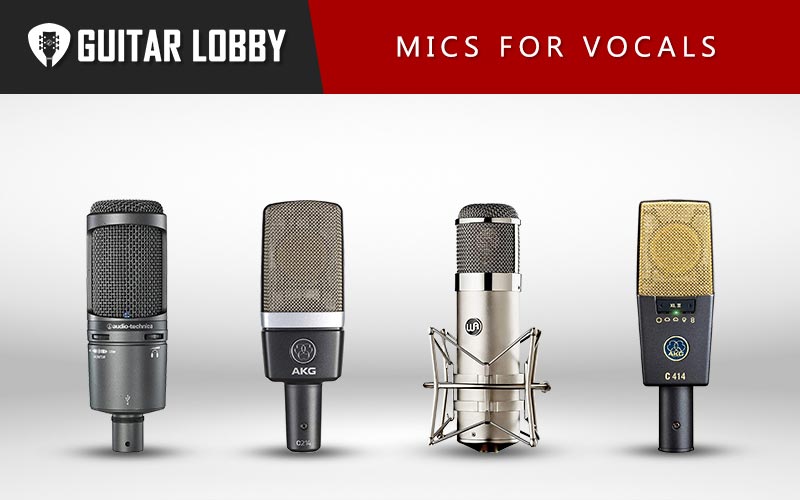
A little tip is don’t fall for the trap of buying an expensive mic just for the sake of its price point, and vice versa, don’t buy a cheap one just for its affordability. Keep your budget in mind but mainly choose a mic that best fits how you’ll use it. You should be looking for the one that will pair well with your vocal range, or one that generally encompasses all the features you need to start recording vocals!
In this guide, I’ll be reviewing the best mics for recording vocals to help you narrow down your picks and find the microphone that best for your space, recording needs, and most importantly, your budget. For more in-depth information, I’ve included a buying guide at the bottom of this article here.
| Name of Product | Image of Product | Description | Price Range | Full Review |
|---|---|---|---|---|
| 1. AKG C414 XLII (Best Overall) | 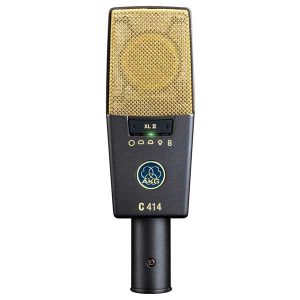 | Microphone Type: Condenser Polar Pattern: Omnidirectional, wide cardioid, hypercardioid and figure-8 + 4 intermediate settings | $1100 | Read Full Review Below |
| 2. AKG Pro Audio C214 (Best Value) | 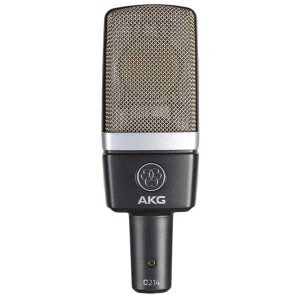 | Microphone Type: Condenser Polar Pattern: Cardioid | $400 | Read Full Review Below |
| 3. Warm Audio WA-47 (Best Under $1000) | 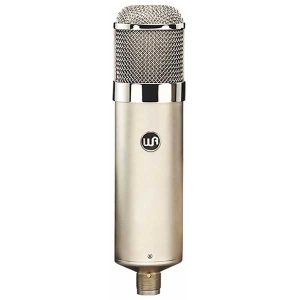 | Microphone Type: Tube Condenser Polar Pattern: Cardioid, Omnidirectional, Figure-8, + 6 patterns in between | $900 | Read Full Review Below |
| 4. Audio-Technica AT2020 (Best Under $100) | 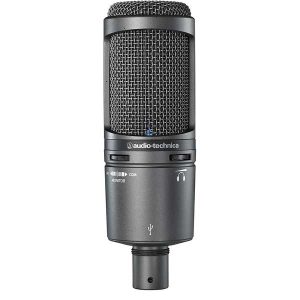 | Microphone Type: Condenser Polar Pattern: Cardioid | $100 | Read Full Review Below |
| 5. Neumann U87 Ai | 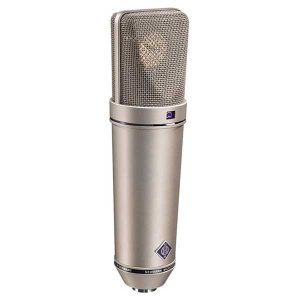 | Microphone Type: Condenser Polar Pattern: Cardioid, Figure-8, Omnidirectional | $3200 | Read Full Review Below |
| 6. Neumann TLM 103 | 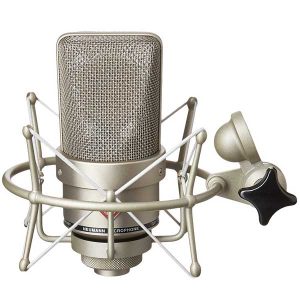 | Microphone Type: Condenser Polar Pattern: Cardioid | $1100 | Read Full Review Below |
| 7. Mojave Audio MA-1000 | 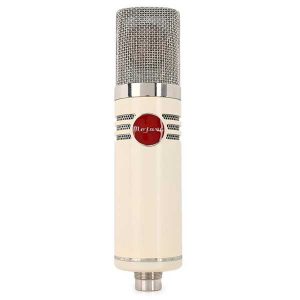 | Microphone Type: Tube Condenser Polar Pattern: Cardioid, Omnidirectional, and Figure-8 | $3000 | Read Full Review Below |
| 8. Audio-Technica AT2035 | 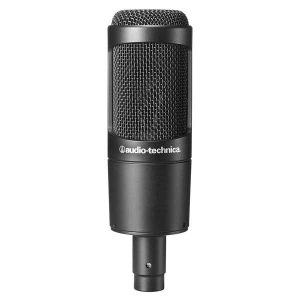 | Microphone Type: Condenser Polar Pattern: Cardioid | $150 | Read Full Review Below |
| 9. Shure SM7B | 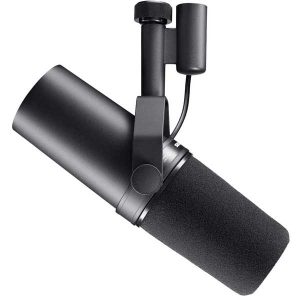 | Microphone Type: Dynamic Polar Pattern: Cardioid | $400 | Read Full Review Below |
| 10. Rode NT1-A | 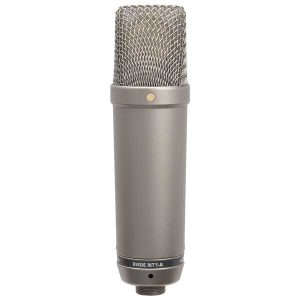 | Microphone Type: Condenser Polar Pattern: Cardioid | $230 | Read Full Review Below |
| 11. Rode NTK | 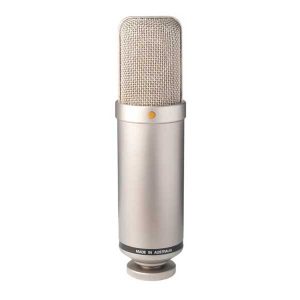 | Microphone Type: Condenser Polar Pattern: Cardioid | $530 | Read Full Review Below |
| 12. Rode NTR | 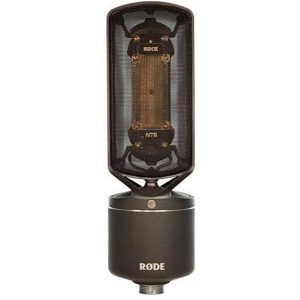 | Microphone Type: Ribbon Polar Pattern: Figure-8 | $750 | Read Full Review Below |
| 13. SE Electronics sE2200a II C Large Diaphragm Mic | 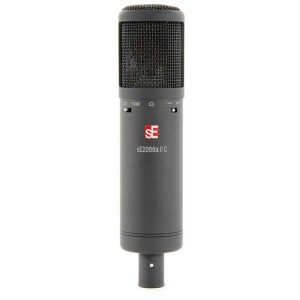 | Microphone Type: Condenser Polar Pattern: Cardioid | $300 | Read Full Review Below |
| 14. SE Electronics X1 S | 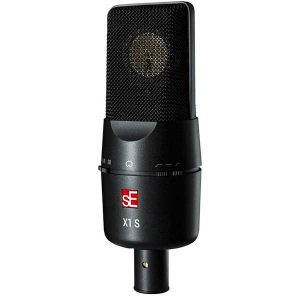 | Microphone Type: Condenser Polar Pattern: Cardioid | $180 | Read Full Review Below |
Here Are the Best Microphones for Vocals
1. AKG C414 XLII (Best Overall)
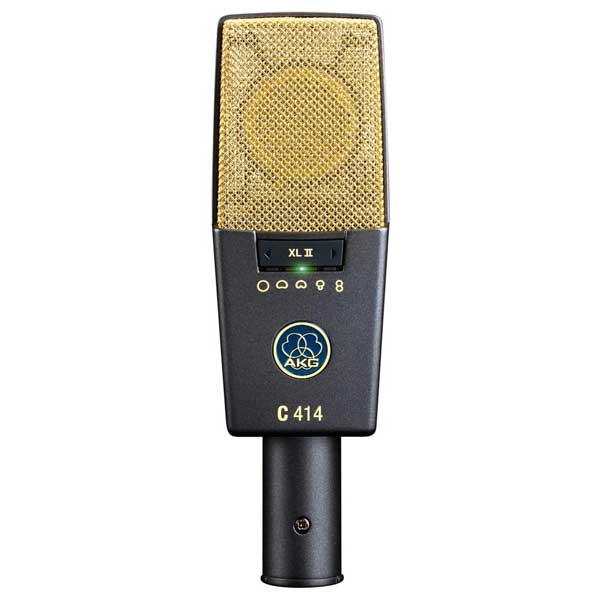
| Estimated Price | $1100 |
| Microphone Type | Condenser |
| Polar Pattern | Omnidirectional, wide cardioid, cardioid, hypercardioid and figure-8 + 4 intermediate settings |
| Diaphragm | Large diaphragm |
| Frequency response | 20 Hz – 20k Hz |
| Max SPL | 158dB |
| Pads | -6; -12; -18 dB |
| Self noise | 6 dB-A |
My Review: The absolute best of the best, the AKG C414 XLII, where can I start? This is one of my favorite mics of all time, along with the C214 and the Neumann TLM103 that we’ll talk about later in this article. Your first impression of this mic may be that it’s too expensive, but in my opinion, the price is completely justifiable.
The C414 XLII is a large-diaphragm condenser mic modeled after the company’s legendary C12. It comes with the option of five different polar patterns, omnidirectional, wide cardioid, cardioid, hyper-cardioid, and figure-8, as well as four other intermediate settings. You would only need the cardioid for recording one person’s vocals, however, there are infinite possibilities for vocal and instrumental applications using other pick-up patterns.
The AKG C414 XLII is one of the most popular mics in the world for a reason. It features multiple attenuation levels, roll-offs, peak hold LED, bass-cut filters, multiple polar patterns, you name it! Perfect for vocals with an airy and open top end that captures a flawless sound. Bass-cut filters reduce unwanted noise while also restricting any proximity effect, which makes the C414 XLII deliver in any space, including live and in-studio. This mic is incredibly versatile and can be used for any type of studio recording, you’ve got yourself a “main” mic that will never disappoint.
On top of its versatility, the ruggedness of the body makes it easy to bring along on tour and live on stage. The price is therefore justified by the fact that you won’t need to buy another mic for any other purpose since it has it all covered.
Who This Mic is Best Suited For: Users who want outstanding sound quality from a brand name that has delivered time and time again. Those who are looking for a durable and hard-wearing mic to take on the road and to last them a lifetime in the studio. Professionals who have experience and will be able to make use of the features and controls to capture sound.
Bottom Line: Overall the AKG C414 is a modern-day classic and an all-around-mic. While some mics are great for specific types of singing or instruments, this one does it all. It works for all voices and styles, captures all the important nuances, and delivers stellar sound. It’s got a flat frequency response across the table, with a few boosts and cuts here and there, as well as multiple polar patterns, controls, and features. You really can’t fault it. It’s a high-end mic with a high-end price with immense value to offer.
2. AKG Pro Audio C214 (Best Value)
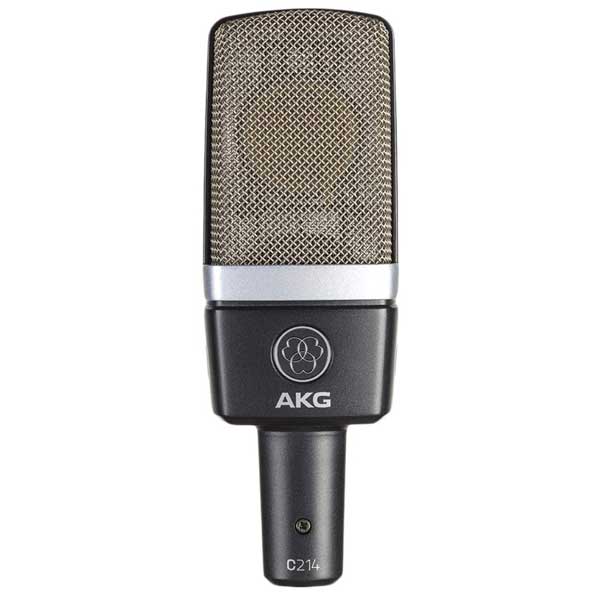
| Estimated Price | $400 |
| Microphone Type | Condenser |
| Polar Pattern | Cardioid |
| Frequency response | 20 Hz to 20k Hz |
| Diaphragm | Large-diaphragm |
| Max SPL | 156dB |
| Pads | -20 dB |
| Self noise | 13 dB-A |
My Review: A condenser mic that offers great value is the AKG C214, with a sound profile modeled after the AKG C414 XLII. The C414 as I mentioned above, is by far my favorite mic for recording vocals, which makes this one my second favorite. You can expect nothing less than exceptional sound quality from the C214.
This model is designed for vocals and trust me when I say it’s got it all. I’ve recorded with this mic many many times, and it delivers exceptional quality. I’ve found that it gives my midrange a lot of body, something that I never found with any other mic. The C214 is the kind of mic you can throw in front of any singer even if they don’t have any recording experience, and it would still sound smooth.
The AKG comes with a range of features, including a switchable 20dB pad and a bass-cut filter increasing the max SPL to an astonishing 156dB. This gives you freedom during recording and allows you to bring out the sound you need without any limitations and without compromising dynamic range.
Although it’s said to have a cardioid polar pattern, this mic is far more omnidirectional than you’d think. It picks up everything. Consider your space before buying this one, the sensitivity of this mic may not be forgiving by any means. Be assured though, due to its high sensitivity, it captures crystal clear detailed sound like no other at this price point.
As far as durability goes, the C214 comes in a shock and scratch-resistant metal die-cast body, which makes it great to take on tour. All of these features and it comes down to just $399, what a bargain!
Who This Mic is Best Suited For: If you love the AKG C414 sound but need a more affordable option, this is the mic for you. This mic is perfect for those who are looking for a durable mic to take on tours and to last in the studio, the AKG C214 would handle all of that with ease. This mic is for people who don’t compromise on sound quality and appreciate all the features it offers.
Bottom Line: This is a mic that delivers in all aspects and never fails to produce world-class sound. This is a pro mic and not what you call a “budget” mic by any means, but the price makes it a good option for anyone still starting out. I would say the only issue is this mic is its high sensitivity, you may struggle a little if you don’t have the noise gate skills to tame the room ambiance that may come through. Overall, I would say that this is the best mic for vocals in terms of overall value.
3. Warm Audio WA-47 (Best Under $1000)
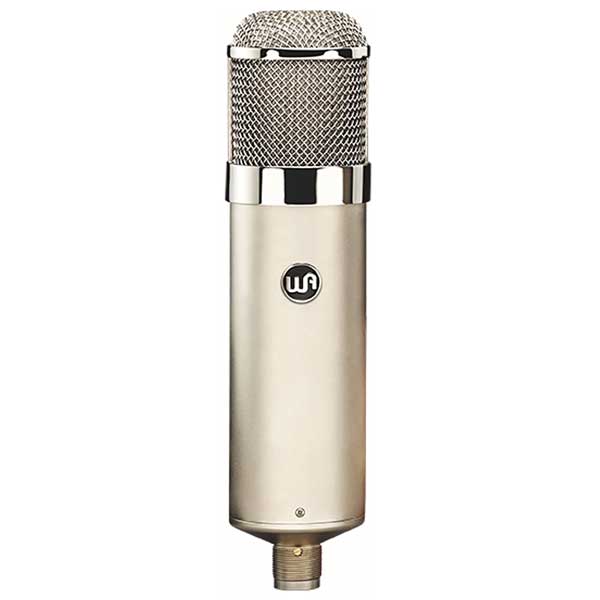
| Estimated Price | $900 |
| Microphone Type | Tube Condenser |
| Polar Pattern | Cardioid, Omnidirectional, Figure-8, + 6 patterns in between |
| Frequency response | 20 Hz to 20KHz |
| Diaphragm | Dual Large Diaphragm |
| Max SPL | 140dB |
| Pads | – |
| Self noise | 11 dB (A) |
My Review: Warm Audio is a brand known to produce modern-day remakes of the classical audio equipment we all love. The Warm Audio WA-47 is known for reviving the legendary vintage sound of the U47. This is the vocal mic that made it through history and the go-to mic for Frank Sinatra and George Martin. It comes with a cardioid, omnidirectional, and figure-8 polar patterns, as well as 6 in between such as wide-cardioid and super-cardioid.
The nine polar patterns put this mic in a league of its own, as well as an incredible 140dB SPL handling giving it versatility and flexibility like no other. With a silky smooth, modern-vintage sound, you can use the WA-47 for any recording you can ever imagine. It sounds sensational and shines on vocals. You can also use it to record piano, guitars, drums, strings, wind instruments, and any other instruments you can think of!
This is a mic that delivers world-class quality and performance at a relatively affordable price while boasting an array of features. The WA-47 also comes at a whopping weight of 9lbs, which many users may admire.
Who This Mic is Best Suited For: People who are looking for a mic with a timeless, modern-vintage sound. Those who are serious and looking to upgrade to a mic with many features and for different vocal and instrumentation purposes long-term. Users who are looking for an alternative to the U47 at a fraction of the cost.
Bottom Line: The Warm Audio WA-47 is the closest mic you’ll find to the U47 in both presentation and sound. The nine polar patterns give great flexibility and impeccable sound quality for any type of recording. Overall, this mic is the real deal and a personal favorite. If you’re a fan of the U47, you’ll love this one! You get way more value than you pay for at this price point. If you’re looking for the best microphone for vocals under $1000 this should be a top contender.
Popular Related Article: The Best DAWS (Free and Paid)
4. Audio-Technica AT2020 (Best Under $100)
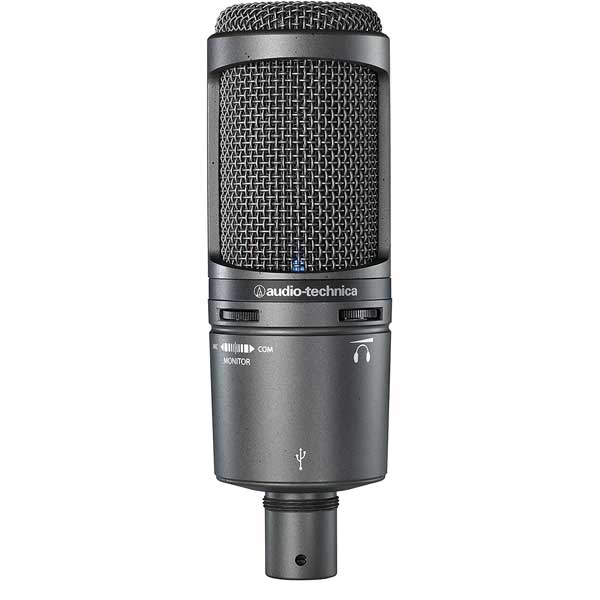
| Estimated Price | $100 |
| Microphone Type | Condenser |
| Polar Pattern | Cardioid |
| Frequency response | Low-mass Diaphragm |
| Diaphragm | 20 Hz to 20KHz |
| Max SPL | 144 dB |
| Self noise | 20 dB |
My Review: The Audio-Technica AT2020 provides great sound quality at an incredibly low price! This is the ultimate affordable condenser microphone in the market and is an ideal choice for home studio applications. Its high SPL and wide dynamic range provide users with versatility while recording.
Similar to their AT2035, it’s cardioid polar pattern lets it capture sounds clearly from the source while simultaneously cutting off background noise. It’s known for capturing sound realistically so that immediately puts it on top of the list if you plan on using it for different purposes. It also comes with a price that is unmatched and would give you room to spend more on the equipment you need to start recording right away.
Who This Mic is Best Suited For: This mic is your go-to if you’re someone who’s setting up your home studio and looking for a low budget condenser. The sound quality and clarity of the AT2020 make it an excellent pick for those who are starting out and don’t want to spend too much on a higher-end mic.
Bottom Line: The AT2020 is a great condenser mic for a studio on a budget. It offers clear and sharp sound while being very easy to set up and mix as well. With countless positive reviews on the web, you are sure to be getting incredible value for the price. I highly recommend this for someone who’s starting out, and you can easily get yourself two if you want to put together a stereo pair! It’s easily one of the best cheap microphones for vocals out there!
5. Neumann U87 Ai
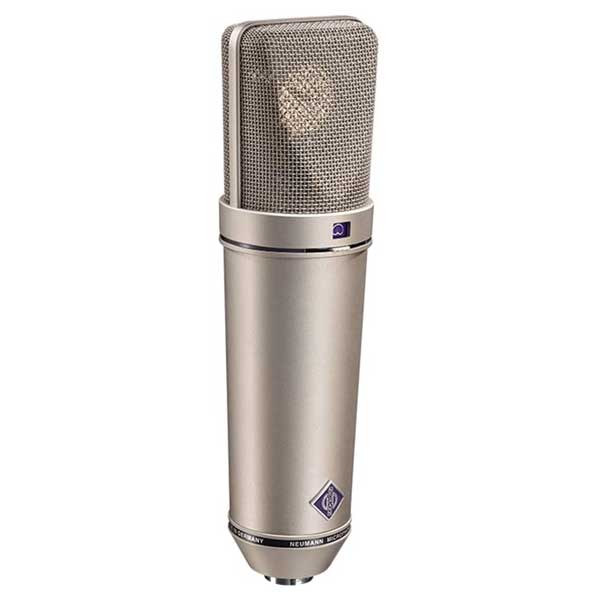
| Estimated Price | $3200 |
| Microphone Type | Condenser |
| Polar Pattern | Cardioid, Figure-8, Omnidirectional |
| Frequency response | Large Diaphragm |
| Diaphragm | 20 Hz to 20 kHz |
| Max SPL | 127 dB |
| Pads | -10 dB |
| Self noise | 12.0 dB-A |
| Weight | 1.1 lbs |
My Review: The Neumann U87 Ai is by far the most popular condenser mic in the industry and one that I’ve been personally keeping my eye on. It’s the one you find when you walk into any professional studio with the design you recognize instantly. Admittedly, it’s the one we all desire to have! The original U87 model was released in 1967 and has a reputation for being the world’s favorite condenser microphone.
The U87 Ai has a smooth, balanced, and refined sound quality which makes it the perfect “main” mic for any professional studio. It comes with cardioid, figure-8, and omnidirectional polar patterns, each of them having a balanced frequency response. This gives you flexibility and freedom in recording with the different pickup patterns.
The U87 Ai is a versatile mic, suitable for all types of recording including vocals, instruments, choirs, orchestras, speech, you name it. This is a legendary model that has made history and is known for its consistent sound no matter the use.
Who This Mic is Best Suited For: This mic is best suited for professional studios or those who want to upgrade to the industry standard. With its price on the higher end, it’s geared towards studio professionals with experience rather than someone who might be still starting out.
Bottom Line: The Neumann U87 Ai is one of the most high-quality and versatile mics out there and its wide range of features makes it a desirable mic for any studio owner. While the price is high, you are sure to be paying for quality and a mic that will be utilized for all purposes.
Related Article: The Best Mics for Recording Electric Guitar
6. Neumann TLM 103
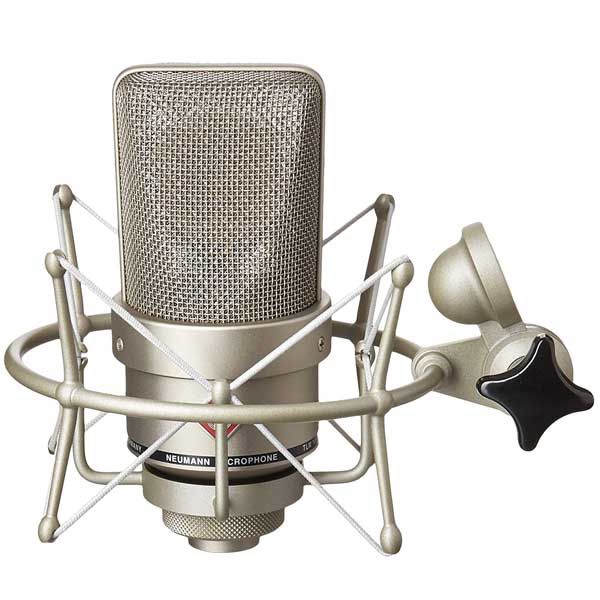
| Estimated Price | $1100 |
| Microphone Type | Condenser |
| Polar Pattern | Cardioid |
| Frequency response | Large Diaphragm |
| Diaphragm | 20 Hz to 20 kHz |
| Max SPL | 138 dB |
| Self noise | 7 dB-A |
| Weight | 0.9 lbs |
My Review: The TLM 103 from Neumann is known as their modern classic mic. It’s modeled after their famous U87 mic, but has one of the lowest self-noise levels of any large-diaphragm condenser mic, at 7dB-A. This makes it especially perfect for vocal and instrumental recording. This mic gives a boost around 6 to 15 kHz which allows the vocals to cut through the mix. It also has a high SPL of 138dB which lowers the risk of distortion regardless of the proximity of the sound source.
Modeled after the U87, the TLM 103 comes with a cardioid pattern, the only pattern needed to record vocals. With this mic, you can be assured that you’d get Neumann-quality sound with pristine presence and clarity. The TLM103’s lower cost, compared to other Neumann models, and low noise levels, makes it a home and professional studio favorite.
Who This Mic is Best Suited For: The TLM 103 is great for those who want a mic with the highest standard of quality from a trusted name in the industry. For recording vocals, speech, and instruments of all types. Those who want to ensure they capture the finest details and nuances. The price point is still high so it’s not geared to someone who’s still experimenting with recording but someone who may have a little more experience and wants to get that world-class sound.
Bottom Line: The Neumann TLM103 has great presence, low noise levels, and incredible sound quality. It can be used to record vocals, speech, and instrument recording using a Cardioid polar pattern, unlike the U87 Ai which gives you the option of all three polar patterns, Cardioid, Omnidirectional, and Figure-8. That makes it less versatile if you’re looking for a multi-purpose mic to record orchestras, choirs, or projects which require sound to be captured from different sources at the same time. That also makes it great for home studios, especially in spaces where you want to eliminate background noise as much as possible. If you’re looking for the best mic for recording vocals this is another one of our top recommendations.
7. Mojave Audio MA-1000
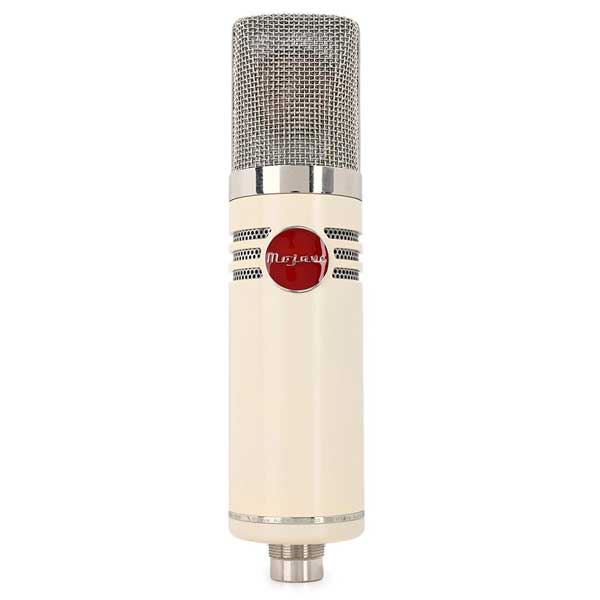
| Estimated Price | $3000 |
| Microphone Type | Tube Condenser |
| Polar Pattern | Cardioid, Omnidirectional, and Figure-8 |
| Frequency Range | 20 Hz to 20KHz |
| Diaphragm | Large Diaphragm |
| Max SPL | 135 dB |
| Pads | 15dB |
| Self noise | 16dB(A) |
| Weight | 1 lb |
My Review: The Mojave MA-1000 is a work of art designed by Technical Grammy award-winning mic designer David Royer. It’s a classic-looking multi-pattern large-diaphragm tube condenser reviving the Telefunken ELA-M 251 sound with a modern touch. This mic is incredibly versatile and excellent for use on all kinds of vocals and instrumentation such as piano, guitars, drums, orchestra, and so much more. It captures the classic tube mic sound combined with accuracy and richness.
The Mojave MA-1000 has a multitude of features that set it apart from any other competitor. With three variable polar patterns, an airy high-end, rich low end, realistic mids, and a state-of-the-art design like no other, you really can’t go wrong with this one! For vocals it’s especially perfect, as it captures the voice realistically along with some room reverb and decay.
Who This Mic is Best Suited For: Someone who’s looking for a mic with lots of features that will serve them in every possible way. Someone who will be using it to record all types of vocals and instrumentation and is willing to make a one-time investment in a mic that will last them a lifetime.
Bottom Line: You really can’t go wrong with the Mojave MA-100. It comes with an array of features, incredible specs, and beautiful design, making it a one-stop-shop for all your recording needs. The only downside to this mic is that it has fairly high noise levels for a mic with this price. It needs a professional recording environment and micing skills to compensate. Another downside is the high price, which you can easily justify given that you won’t need another mic if you own this one!
Related Article: Our Favorite Wireless Guitar Systems (All Price Ranges)
8. Audio-Technica AT2035
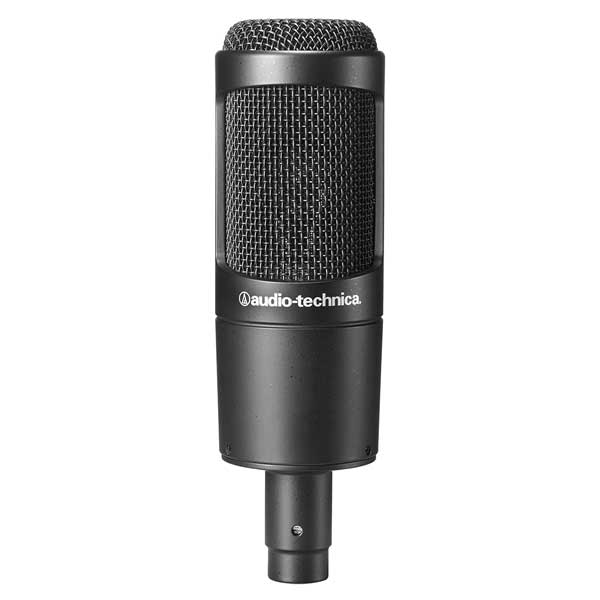
| Estimated Price | $150 |
| Microphone Type | Condenser |
| Polar Pattern | Cardioid |
| Frequency Range | 20 Hz to 20KHz |
| Diaphragm | Large Diaphragm |
| Max SPL | 158 dB |
| Pads | 10 dB |
| Self noise | 12 dB |
| Weight | 0.9 lbs |
My Review: Audio-Technica are one of the most reputable brands that produce affordable and mid-budget mics. Their AT2035 model is a popular pick amongst home studio owners and vocalists. This mic is steady and reliable and offers a smooth, natural sound. It’s also designed with a high SPL so it’s able to handle all types of vocals, which proves that you don’t need to spend $1000+ to get premium quality.
The Audio-Technica AT2035 is a large-diaphragm condenser with a cardioid polar pattern, a switchable 80Hz high-pass filter, and a 10dB pad which makes it an excellent choice for recording clear vocals while blocking out any outside noise. As most home studios aren’t professionally treated, this mic is perfect for capturing vocals in a non-perfect recording environment.
One of the great things about this mic is that it’s sturdy and rugged, and comes with a custom shock mount meaning it’s very practical and can be a good option to take with you on the road as well as in the studio.
Who This Mic is Best Suited For: The Audio-Technica AT2035 proves perfect for those who are just starting out in a home studio setting. If you’re a recording artist or vocalist looking for a high-quality mic at an affordable price, then this mic will be suitable for all your needs.
Bottom Line: Overall, this mic offers value like no other within its price range. It’s mainly used for vocal and instrumental applications and its relatively low noise levels make it the right fit for any home studio. Its reliability and sturdiness serve as an asset to any creator on the road. This mic is a great deal and worth every penny! If you’re looking for the best mic for vocals under $200 the Audio-Technica AT2035 is one of my top recommendations. The Rode NT1-A reviewed below is also a great mic that’s priced similarly.
9. Shure SM7B
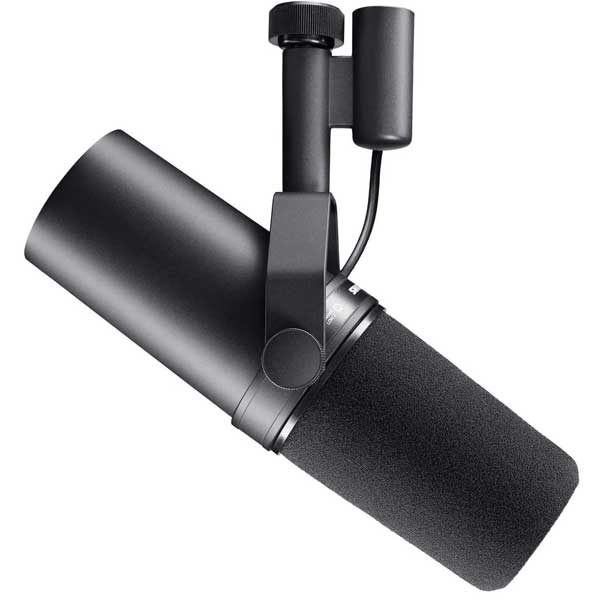
| Estimated Price | $400 |
| Microphone Type | Dynamic |
| Polar Pattern | Cardioid |
| Frequency Range | 50 Hz to 20KHz |
| Weight | 2 lbs |
My Review: This Shure SM7B has been recommended to me time and time again by audio engineers when I was looking to buy my first studio mic. At first, I really couldn’t understand why people were telling me to buy a dynamic mic for recording, weren’t those only meant to be used live? Well, no, and this isn’t just another one of those dynamic mics in the market. The Shure SM7B is the iconic mic that everyone associates with Michael Jackson. This is the one he used to record “Thriller”. It’s also used by so many of my favorite artists that I just had to find out why.
One of the main reasons that people love the Shure SM7B for recording is that it has a flat, wide frequency response. That means it captures sound as it is, with little tonal difference or added character. The bass roll-off and mid-range emphasis give a presence boost and voices come through clear and realistic, making it a great choice for vocals and speech. It also comes with a pop filter like no other, in addition to the A7WS external windscreen so no matter how close you get to the mic, you can be sure that it will deliver clean sound every time.
The Shure SM7B is an extremely reliable and consistent microphone. It’s built with a cardioid polar pattern which ensures rejection of unwanted noise coming from the rear. It’s a great choice for both home and professional studios. It’s also shielded to block any electromagnetic hum that may be irritating, proving its capabilities as a reliable vocal and broadcasting mic.
Bottom Line: The Shure SM7B is a versatile microphone, you really can’t go wrong with it. It’s reliable, consistent, and has great sound quality. It emphasizes presence and clarity and delivers professional quality with very low noise. Great for vocals, voice-overs, broadcast, live recording, drums, guitar, woodwinds, and more. It comes with a pop filter and windscreen so there’s no need to look for additional accessories, it’s a complete studio package!
Who This Mic is Best Suited For: Those looking for the ultimate go-to mic to deliver realistic and crystal clear sound with a mid-range budget. Those who want a reliable microphone that will deliver exceptional sound every time. This mic is great for both home and professional studio use. If you’re looking for the best mic for recording vocals this should be a top contender.
Popular Article: The Most Accurate Guitar Tuners Available
10. Rode NT1-A
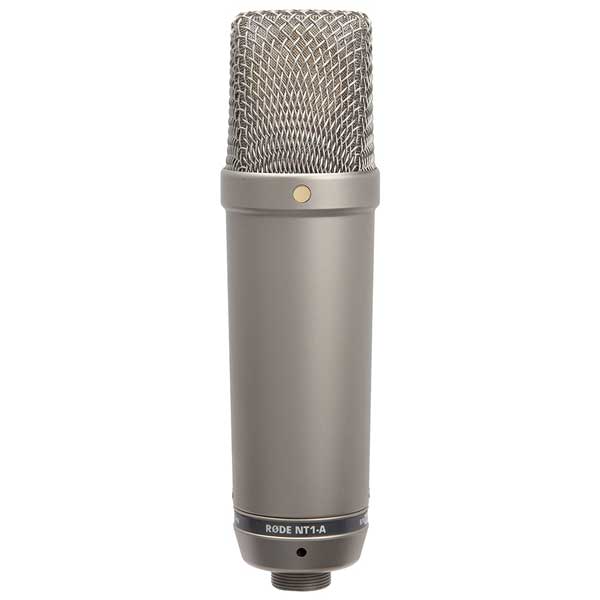
| Estimated Price | $230 |
| Microphone Type | Condenser |
| Polar Pattern | Cardioid |
| Frequency response | Large Diaphragm |
| Diaphragm | 20 Hz to 20KHz |
| Max SPL | 137dB |
| Self noise | 5dB(A) |
My Review: The Rode NT1-A is a remodel of the famous NT1 classic studio microphone. It’s known as the quietest condenser microphone in the market. It has an astonishing self-noise level of just 5dB, making it a flawless vocal mic as well as great for recording guitar, percussions, and more. The low noise levels ensure that it will pick up quieter instruments with ease, and with better quality than other mics at its level.
This is an all-around practical mic that delivers crystal clear sound. A high SPL handling, typically attributed to more expensive mics, gives it the flexibility to capture sound perfectly without distortion, no matter the loudness. Its large gold plated diaphragm delivers warm and smooth vocals. Don’t be fooled by the price, there is nothing less than world-class about the quality of the NT1-A. If you’re on a budget then you’ve hit the jackpot with this mic.
Who This Mic is Best Suited For: The Rode NT1-A is ideal for home recording and perfect for anyone looking to buy their first microphone. This mic delivers realistic sound so it works well on all vocals and instruments. Priced at just $229, this mic is the right choice for those on a low budget but still want a stellar sound. However, it isn’t the type of mic that will add character and texture to your recording, so if that’s the type you’re looking for that then keep reading on!
Bottom Line: Overall, The NT1-A delivers professional sound quality regardless of its low price. This mic would be ideal for those who will use it on a wide range of recording applications as it delivers a clear realistic sound. Its affordability and sound quality make it one you should consider for your home studio.
11. Rode NTK
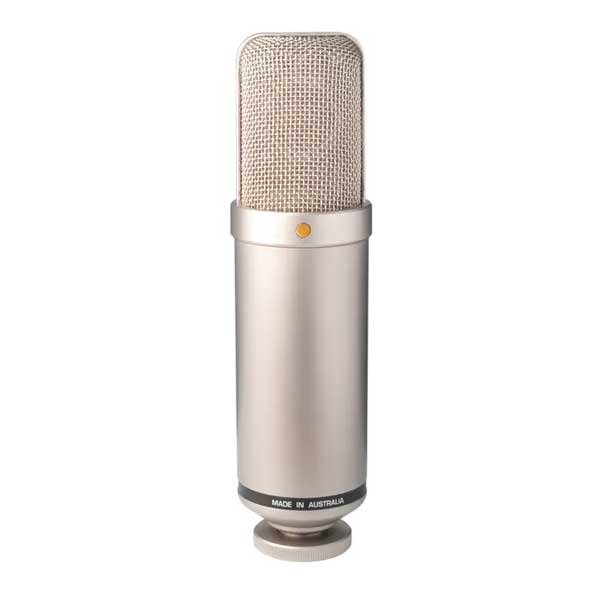
| Estimated Price | $530 |
| Microphone Type | Condenser |
| Polar Pattern | Cardioid |
| Frequency response | 20Hz-20kHz |
| Diaphragm | Large Diaphragm |
| Max SPL | 158dB |
| Self noise | 12dB(A) |
| Weight | 1.68 lbs. |
My Review: Similar to the Mojave Audio MA-1000, this is another tube condenser that carries a modern-vintage sound. But unlike the MA-1000, this one comes with a much more affordable price tag. The sound characteristics of this mic are somewhat warm with a gentle presence boost, working best with vocals around the higher range. This is a mic with a specific vintage character and truly shines and brightens upper frequencies, but you can always change the tube to get a different sound.
It has a self-noise level of 12dB meaning it captures sound as it is without any interruptions. But, if you need lower noise levels then check out the Rode NT1-A which has a noise level as low as 5dB. It’s known as the world’s quietest mic for a reason!
Back to the NTK, this mic has a max SPL of 158dB which is incredible for a mic at that price. It’s reassuring to know that a mic can handle sound no matter the proximity of the source. It won’t disappoint even if you’re singing at the top of your lungs! The mic also comes with its own power supply and doesn’t need phantom power, but you’d have to turn it on 30 minutes before your session to get it warmed up!
Who This Mic is Best Suited For: Lovers of that warm vintage sound who are looking for an added character on their recordings. Those who want an additional specialty mic to add to their collection. The Rode NTK is a highly sensitive mic and would need a professionally treated recording room, so if your home studio is next to the bathroom or has a loud air conditioner, this is not the mic for you.
Bottom Line: The Rode NTK is an incredible specialty mic for any professional studio. It shines on vocals and instruments with a higher frequency range. This mic delivers professional sound quality with a beautiful vintage character way above its price point. However, it doesn’t provide a flat “realistic” sound so it might be better with some recording applications than others. It also needs at least 30 minutes to warm up and you can tell a difference in the sound when you let it take its time. This is something you might want to consider if you’re impatient like me when inspiration hits!
12. Rode NTR
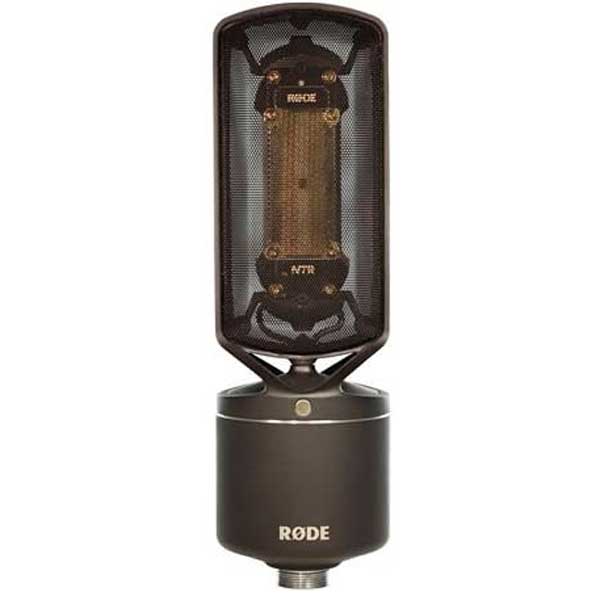
| Estimated Price | $750 |
| Microphone Type | Ribbon |
| Polar Pattern | Figure-8 |
| Frequency response | 20Hz – 20kHz |
| Max SPL | 130 dB SPL |
| Self noise | 15dB-A |
| Weight | 3.6 lbs |
My Review: This is the Rode NTR, a piece of art, and the first ribbon mic to make it on this list! I’m not sure where to begin with this beauty, it ticks all the boxes of how a ribbon mic should sound. Perfectly smooth, clear, and even sound captured perfectly with a figure-8 polar pattern. Beautiful presence and detailed sound at higher frequencies, quite the opposite of most ribbon mics.
Uniquely designed and beautifully manufactured with a hefty weight of 3.6 lbs, this ribbon mic is one that I’ve kept an eye on. It’s sturdier than the average ribbon mic, which makes it less likely to be damaged.
The NTR’s self-noise is at 15 dB-A, which is not the best compared to large-diaphragm condenser mics, however, to a small diaphragm condenser it’s at an average level. The SPL is at 130 dB which doesn’t surprise me for a ribbon mic, as they’re highly sensitive compared to the other mic types. On the plus side, it’s designed impeccably, and the price point is affordable for the quality it delivers.
For the best vocals, record while you’re slightly away from the mic. Very close vocal micing overwhelms the ribbon mic and delivers an unnatural mid-range. You’ll most probably need a professional space to be able to enjoy this mic to the fullest.
Who This Mic is Best Suited For: Those who will record vocals in a professional sounding space. If you want the luxury of a beautiful ribbon mic at a very affordable price, the NTR would be perfect for you. If you have a less than ideal recording space, I suggest you consider one of the condensers on this list!
Bottom Line: The Rode NTR is one of the greatest affordable ribbon mics in the market. It could be a beautiful addition to your studio alongside your main mic. If you’re looking to record distinct sounding vocals and would care for a fragile piece of equipment like a ribbon mic, then go for it. Keep in mind though, It doesn’t have a cardioid polar pattern so it won’t pick up vocals from one direction only, but also the room’s reverb and ambiance.
13. SE Electronics sE2200a II C Large Diaphragm Mic
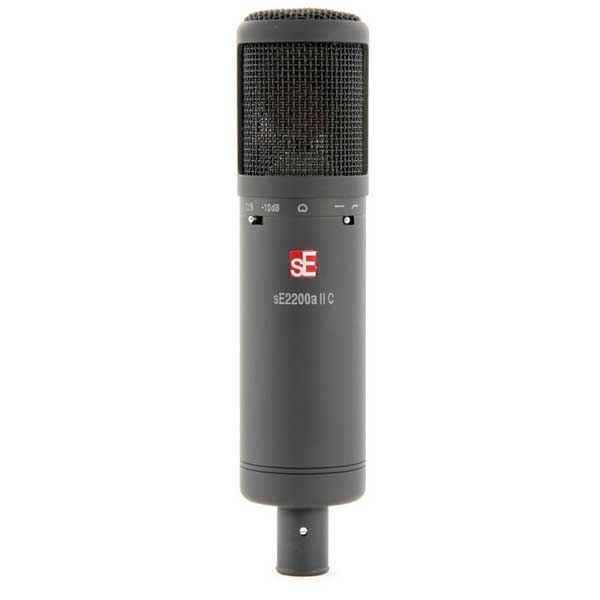
| Estimated Price | $300 |
| Microphone Type | Condenser |
| Polar Pattern | Cardioid |
| Frequency response | 20 Hz – 20k Hz |
| Diaphragm | Large diaphragm |
| Max SPL | 145 dB |
| Pads | -10/20 dB |
| Self noise | 12dB-A |
| Weight | 2.79 lbs |
My Review: The sE2200a II C is a mic made specifically for vocal recording. It’s modeled after the brand’s most popular mic the sE2200a, which was used by Amy Winehouse for her album “Back to Black”. With the difference of having an improved finish and bundled shock mount, the sE2200a II C comes with most of the features of the original mic.
A large handmade 1-inch gold-sputtered diaphragm condenser with a cardioid polar pattern delivers a smooth and expensive sound. This mic shines on vocals and gives them a clear airy sound due to the slight boost at 10kHz. It’s great for many types of singing and the pad provides flexibility to record louder sounds if needed.
The cardioid polar pattern makes it perfect for home studio use as it just picks up sound from the source and rejects anything coming from the back.
Who This Mic is Best Suited For: This mic is made for recording vocals and is fit for home studio use as it doesn’t pick up any sound other than the source. Anyone on a budget looking for a special mic with sound quality that surpasses its price point, this is the one.
Bottom Line: The sE2200a II C is a mic that sounds more expensive than it looks, and the handmade gold-sputtered diaphragm makes this model a special one. It has all the main features you’d need to record vocals in a home studio setting. All in all, it’s a great mic with a great price and quality that will impress.
14. SE Electronics X1 S
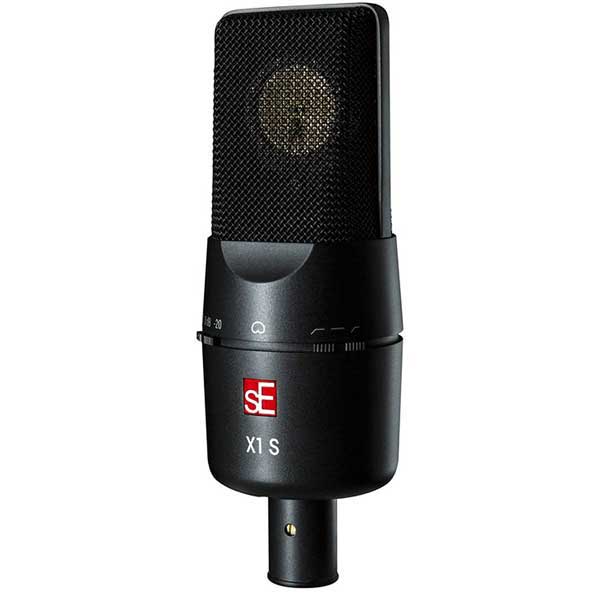
| Estimated Price | $180 |
| Microphone Type | Condenser |
| Polar Pattern | Cardioid |
| Frequency response | 20 Hz – 20k Hz |
| Diaphragm | Large diaphragm |
| Max SPL | 160 dB |
| Pads | -10/20 dB |
| Self noise | 9 dB(A) |
| Weight | 0.97 lbs |
My Review: If you’re looking for a workhorse mic to record vocals and other studio applications, then the sE Electronics X1 S could be the one you’re looking for. The X1 S is the refined version of the X1 model by sE Electronics. With the highest dynamic range and SPL handling capabilities amongst its competitors, it has been upgraded tremendously while being more affordable than the original model.
Just like the sE2200a II C, it comes with a large handmade 1-inch gold-sputtered diaphragm condenser with a cardioid polar pattern that delivers clarity and precision. Cardioid is the best polar pattern for vocals and for sound isolation from the rear as you need in a home studio with less than ideal treatment.
The mic comes with two switchable pads at -10dB and -20dB so it provides flexibility in dynamic range. That gives the mic a higher SPL handling and allows for close micing techniques and the ability to record loud instruments without distortion. There are also two low-cut filters to omit low-frequency noise, as well as a way of compensating for excessive bass.
Who This Mic is Best Suited For: The sE X1 S is great for those still starting out and need a vocal mic for their home studio. It’s affordable but still provides the high quality you’re looking for in a studio mic.
Bottom Line: It’s hard to beat a mic with great qualities and a great price. If you don’t want to spend much on a mic but still want good sounding vocals, this mic will meet all your sound needs. It’s a versatile mic that would pair well with many singing styles including louder recordings as it has a max SPL of 160 dB which is more than one will ever need!
Choosing the Right Mic for Vocals (Buying Guide)
There are so many mics available in the market and they come with different features, designs, and specs. In my reviews, I’ve mentioned many terms that you may not necessarily be familiar with. I’ll be explaining everything in more detail in this buying guide, that way you’ll have all the information required to confidently choose the mic that best fits your recording needs.
If you’re not into the technicalities of the process, it may be a bit difficult to grasp some of the concepts and may not be enjoyable for you but it’s very important to understand the basics before making your purchase so you can make sense of the features and specs of each mic and how they translate in terms of output quality.
What Are the Different Types of Microphones?
There are mainly three types of mics, condenser mics, dynamic mics, and ribbon mics. They all have different qualities and are used for different recording applications. The difference in how they work is in how the diaphragm picks up and translates the audio signal coming from a sound source.
Condenser Mics
Condenser microphones have a flat frequency response and are mostly used for studio recording. In condenser mics, the diaphragm is one of the two metal-surfaced plates that vibrate as you sing or play an instrument. When the sound waves hit the diaphragm, it vibrates and creates a distance between the two plates changing the capacitance. A voltage is required for this to happen, that’s why most condensers need a 48V phantom power source to work.
There are large-diaphragm condensers and there are also small-diaphragm condensers. The large-diaphragm condenser mics are the ones you picture when you think about the typical recording mics in a professional studio. They’re the ones that look professional and serious and come in all sorts of sleek designs. These are the mics that capture that world-class sound quality you get when you record vocals in a pro recording studio.
Large-diaphragm condensers have a diaphragm size of 1” or more and sometimes come with selectable polar patterns, which I will explain in-depth later, but that gives them the ability to work well in many vocal and instrumental recording situations. If you want one mic that can handle whatever studio task you throw at it, I highly recommend you go for a large-diaphragm condenser.
Small diaphragm condensers have a diaphragm size smaller than 1”. Unlike the large diaphragm condensers, these don’t come with selectable polar patterns. That may limit their versatility in recording situations, however, their small size makes them perfect for micing specific instruments and for recording in small spaces where a large-diaphragm mic wouldn’t be ideal.
They’re mostly known for capturing clear realistic sound without any coloration, which makes them the perfect tool to use on piano, drums, percussions, acoustic guitars, string instruments, and much more. Small diaphragm condensers are loved by classical sound engineers and are sometimes exclusively used to record orchestras and choirs.
Dynamic Mics
Dynamic or “moving-coil” mics as they sometimes call them, work a bit differently than condensers. There are three components to the body: a diaphragm, a coil attached to that diaphragm, and a magnet surrounding the coil. As you sing or play and instrument in a dynamic mic, the sound waves move the diaphragm attached to the coil, the magnet that surrounds the coil causes it to create electrical energy. This process of using a magnet to transform acoustic energy into electrical energy is called electromagnetism.
These mics don’t need any power source to operate and are much less sensitive and fragile than condenser mics, that’s why we use them mostly for live performances and events. Dynamic mics can handle high sound pressure levels which makes them great to use for recording loud sound sources like drums. The downside is generally because they’re less sensitive, they don’t capture as much sound detail as condensers do. However, there are some excellent dynamic mics known to be used for recording vocals, like the Shure SM7B for example. They’re very affordable, sturdy, and versatile. It won’t hurt having one or two dynamic mics in your studio for recording vocals, alongside your “main” mic.
Ribbon Mics
Ribbon mics were very popular in the 50s and 60s, and date back to the early recording days, but some professional studios still use them today. They’re so expensive and fragile so it’s very uncommon that people would use a mic like that in a home studio setting. Ribbon mics are kind of similar to dynamic mics in the way they work in transforming acoustic energy to electrical energy using a magnet. The only difference with ribbon mics is that instead of a coil and a membrane, they use a strip of aluminum foil.
People love ribbon mics for their silky smooth vintage tone, and that’s because they’re designed to create a roll-off on their high frequencies resulting in a flawless sound. They capture sound with a figure-eight polar pattern. But because they’re so fragile and have very low SPL handling, they’re very easy to break. They need to be handled with the utmost care, if you accidentally blow in them or move them too hastily, the ribbon can be easily damaged. Unlike condensers, the one thing you must not do with ribbon mics is supplying them with 48V phantom power, that will literally fry the mic.
What Are the Different Polar Patterns?
An understanding of polar patterns is essential in knowing which mic you need for your recording purposes, but sometimes it gets really confusing! In simple terms, the polar pattern is the pickup pattern of the mic, meaning the directions/angles in which the mic will capture the sound. Knowing this information will help you decide if a mic would be suitable for what you’re intending to use it on.
There are three main polar patterns that you should know about, cardioid, figure-eight, and omnidirectional. There are also multiple patterns in-between!
Cardioid
The cardioid polar pattern is the most common one and probably the most familiar. The cardioid pattern is heart-shaped, and that’s exactly what the word “cardioid” means. This is how the mic will pick up sound by capturing the sound waves coming from the front (with a slight angle to both sides) and rejecting any sound coming from the back. This is perfect if you’re recording vocals or speech and you want a clear sound straight from the source while minimizing any unwanted noise from the room. Condenser mics can be cardioid only or they can have multiple pattern options, while dynamic mics are usually just cardioid.
Figure-eight or Bidirectional
As the name suggests, the figure-eight polar pattern picks up sound in an “8” from only two directions. Sound is captured from the front and the back of the mic while rejecting sounds from both sides. This pattern is usually used for interviews with two people speaking, or for recording instruments at opposite sides of the room while maintaining the separation needed for a good sounding mix. Ribbon mics are typically designed with a figure-eight polar pattern and are frequently used to record in stereo.
Omnidirectional
Omnidirectional, sometimes referred to as “omni”, is a pattern shaped like a sphere and picks up sound coming from all angles. So not only do you get sound coming from a specific source but also it picks up everything else in the space. This is amazing for recording all kinds of vocals, instruments, orchestras, and choirs while also picking up the ambiance and reverb of the space. This adds a whole other dimension to the recording and gives me goosebumps even thinking about it!
Now that you know more about polar patterns and the different mic types, you can decide for yourself which ones you need to start capturing the right sound for your recordings. But before you start narrowing down your picks, I still want to talk about a few important specs to look out for and how they can translate into sound output.
Frequency Response
A microphone’s Frequency response tells us the range of frequencies that will be picked up by that mic and it’s measured in Hertz. For example, if a mic has a frequency response of 50 Hz to 20k Hz and you want to record drums, then that mic wouldn’t work well. You would need to use a mic with a frequency response that at least starts at 30 Hz to be able to capture lower-end frequencies. However, the frequency response doesn’t tell us how the mic specifically delivers at different frequencies. For that, you would need to look at the mic’s frequency response chart to see if there are any boosts or peaks that give the mic character.
Max Sound Pressure Level
A microphone’s sounds pressure level or “SPL” tells us how much loudness a mic is capable of handling. That shows us the mic’s limits and where it will begin to distort. Some condenser mics have pad settings that can be turned on to give some space for loud recording situations. Those pads are usually in the -10/20 dB range.
Self-Noise
Self-noise is a huge factor to consider while buying a mic. This is the sound that the mic produces itself without a sound source. It’s a fact, no-one wants a noisy recording and no-one wants to keep compromising their mic placement to balance out that noise. So having a quiet mic means you’ll have clearer recordings and the freedom of placing it as close or as far to the sound source as you’d like!
Self-noise levels are measured as dB-A level. “A Weighting” is the most common weighting that is used in noise measurement. Anything mic with self-noise between 0 dB-A and 19 dB-A is an extremely quiet mic. Above that level is not a good level for a recording mic because the noise at this point is noticeable and can be heard even in the middle of a mix.
Condenser mics are usually in that range, and of course the lower the level the better. It gives you room to record even the quietest instruments without any noticeable noise. You’ll find that it’s very rare to find noise level specs for dynamic mics, that’s because dynamic mics are mostly dependent on the preamp.
Context is super important to keep in mind while comparing mic noise levels. For example, if you’re going to be recording classical music, you’ll need a mic with very low self-noise. But, if you’ll be recording rock vocals or metal screamers, then a higher noise level won’t make that much of a noticeable sound.
It’s more expensive to manufacture mics with low noise levels, so when you find an affordable mic like the Rode NT1-A with a 5dB-A noise level, know you’ve got yourself a great deal!
How Does a Mic Work?
First, let’s get back to basics and think about how microphones work. A mic is a device that converts acoustic energy (the sound coming in from the source) into electrical energy. That electric energy is what we call the “audio signal” and the diaphragm is what picks it up and translates it. To make it easier, think of it this way, speakers are just like mics but backward, meaning they convert electrical energy (audio signal) back into acoustic energy (the sound that comes out). How awesome is that?
Other General Things To Keep in Mind
We don’t all have the option of trying out mics before we buy them, so there are a few things to think about and ask yourself to make sure you make the right choice. The first question to ask yourself is how will you be using the mic? Are you only recording your vocals or do you need a mic to suitable for different singing styles?
What if you need a mic for general studio use and one that you’ll use to record many types of vocals with? In that case you should choose a mic that picks up sound clearly and realistically. You’d need a mic that doesn’t have a specific color or tone so that it could apply to different recording situations. Generally, high SPL, a low self-noise level, and multiple polar patterns should cover you. It’s going to be your main mic and you probably won’t be upgrading for a long time, so make sure it ticks all your boxes!
The second question you should ask yourself is what type of space will you be recording in? Is it a home studio with lots of outside noise coming through, or is it a professionally treated and soundproofed room? Will you be recording vocals in a space where you’d want to capture its unique acoustics and ambiance? Based on that you can choose a mic with the polar pattern that fits your space. For non-treated rooms, it’s best to go with a dynamic mic or a condenser with a cardioid pattern to minimize noise. If you want to capture the reverb of a room, it would be better to go for a mic with an omnidirectional pattern.

My name is Malak and I have extensive experience singing, songwriting, and vocal recording. I have been a professional singer, songwriter, recording artist, and audio editor for over years now, working on many challenging projects.
My tracks were featured on the biggest Spotify playlists like New Music Friday, Fresh Finds, and Pop Rising. My music was also reviewed on Rolling Stone, and featured on Notion, Elle, and other big magazines!

What mic did Billie Eilish use to record Ocean Eyes?